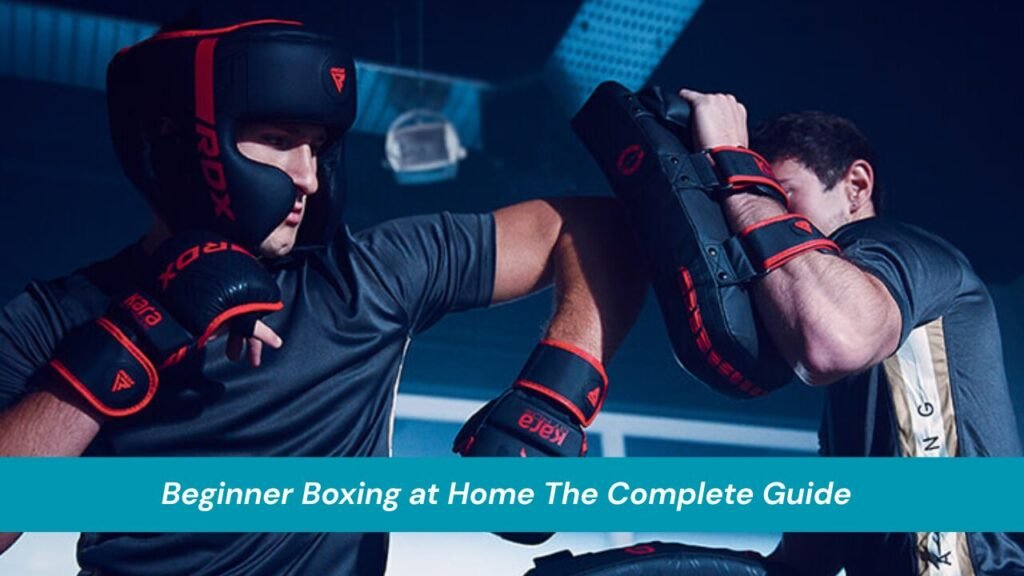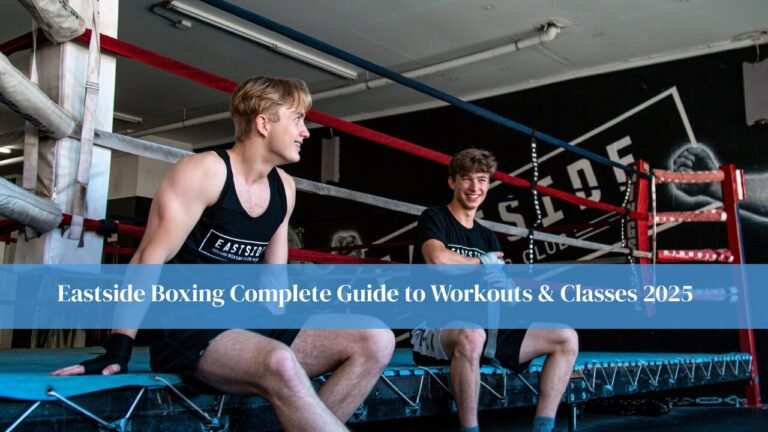Boxing has always carried an aura of toughness, grit, and discipline. Images of legendary fighters like Muhammad Ali training in modest gyms or Rocky Balboa pounding away in a darkened basement have fueled generations of people who wanted to lace up the gloves. But in today’s world, you don’t need a gritty boxing gym, a professional trainer, or expensive equipment to reap the benefits of the sport. You can start boxing right where you are, and this is where the concept of beginner boxing at home comes in.
For newcomers, training at home offers flexibility, privacy, and accessibility. Whether you are motivated by fitness goals, the desire to learn self-defense, or simply the appeal of trying something new, boxing is an incredibly rewarding journey that combines physical training, mental toughness, and personal discipline. In this comprehensive guide, we’ll break down everything you need to know to begin boxing at home, from the basics of stance and punches, to structured drills, equipment suggestions, safety tips, and even the mindset that separates those who stick with it from those who give up. By the end, you’ll have a clear roadmap to start your journey with confidence.
Why Start Boxing at Home?
Boxing is unique because it blends cardiovascular training, strength building, coordination, and strategy all into one activity. Unlike some workout programs that can feel repetitive, boxing is dynamic, engaging, and challenging in ways that keep you motivated. Training at home makes it even more appealing because you don’t need to schedule gym classes, commute across town, or worry about being self-conscious in front of others.
At home, you can practice in your living room, garage, or backyard, fitting workouts into your schedule whenever it’s convenient. Many people start this way because it eliminates barriers to entry. You don’t need to worry about sparring with experienced fighters or investing in expensive equipment. Instead, you can focus on learning the fundamentals of stance, movement, and technique, all while building your fitness level.
The benefits extend beyond convenience. Boxing is one of the best calorie-burning workouts available. A vigorous 30-minute boxing session can burn between 300 and 500 calories, depending on your weight and effort level. In addition, the constant movement improves cardiovascular health, while the repetitive punching builds upper body strength, and the need to stay balanced and agile enhances your core and lower body. Just as important, boxing provides a powerful outlet for stress. The rhythm of striking and the intensity of the workout can clear your head and release built-up tension.
Setting Up for Success Equipment You’ll Need
Many beginners wonder if they need a full boxing gym in their garage to get started. The truth is, you can start boxing with little more than your own body and a safe space to move. Shadowboxing, where you practice punches and movement without a bag, is an effective and time-honored method that requires no equipment. Still, investing in a few basic items can make your training safer, more effective, and more enjoyable.
Hand wraps and gloves are essential if you plan on hitting a bag. Wraps protect your knuckles and wrists by keeping everything tightly supported, while gloves add padding to reduce impact on both your hands and the bag. A heavy bag, while not strictly necessary, is a fantastic tool for practicing power, timing, and endurance. Even a free-standing bag or a double-end bag can work in limited spaces.
Jump ropes are another staple of boxing training. Skipping rope isn’t just a warm-up—it’s a skill that builds rhythm, coordination, and footwork. It conditions your legs for the constant movement boxing requires and develops endurance in a way that transfers directly to the ring, even if you never plan to step into one.
Finally, a mirror can be one of your best training partners. Being able to watch your stance, hand position, and movement in real time helps you catch mistakes before they become habits. Resistance bands, light dumbbells, and bodyweight space can round out your setup, giving you a versatile home gym that supports both boxing and general fitness.
Building the Foundation Stance and Basic Punches
Before you throw yourself into intense workouts, you need to master the building blocks of boxing. The stance is the foundation. Without a solid stance, your punches will lack power, your defense will be weak, and your balance will be constantly at risk. To establish the stance, stand with your feet shoulder-width apart and your non-dominant foot slightly forward. Your knees should remain slightly bent, weight balanced on the balls of your feet. Keep your chin tucked, elbows close to your ribs, and hands up to protect your face.
Once you’re comfortable with the stance, you can begin practicing the four core punches: the jab, cross, hook, and uppercut. The jab is your lead hand punch, quick and straight, used to set up combinations and control distance. The cross comes from your rear hand, thrown with more power as you rotate your body through the punch. Hooks are circular punches aimed at the side of your opponent’s head or body, while uppercuts travel upward, ideal for close-range situations.
Every beginner should spend significant time drilling these punches individually before moving into combinations. The key is not power but precision and technique. Practicing slowly, in front of a mirror if possible, ensures you’re developing correct habits. As you grow more comfortable, you can string punches together, creating combinations like jab-cross or jab-cross-hook. These patterns form the backbone of offensive boxing.
Training Drills for Beginners
Training at home should mimic, as closely as possible, the structure of a real boxing workout. That means blending technique practice, conditioning, and footwork into one session. Shadowboxing is one of the most effective drills you can perform. Imagine an opponent in front of you, move around your space, and throw punches with purpose. Shadowboxing not only develops your technique but also helps you visualize how to react in different scenarios.
If you have access to a heavy bag, dedicate rounds to practicing specific punch combinations. For instance, spend one round throwing only jabs, focusing on speed and snap. In the next, work jab-cross sequences, paying attention to body rotation. Gradually add hooks and uppercuts as your comfort grows. Treat these rounds like real fights, working in bursts of intensity followed by moments of resetting and moving.
Jump rope sessions are another must. They not only build cardio but also develop the lightness of footwork that separates good boxers from beginners. Start with a few minutes and build up to longer intervals as your coordination improves. Finally, add conditioning exercises such as push-ups, squats, and sit-ups to round out your training. These exercises mimic the strength demands of boxing and build endurance to sustain you through multiple rounds.
Structuring a Complete Home Boxing Workout
One of the challenges of training at home is knowing how to structure your sessions. Without a coach calling the shots, it’s easy to drift aimlessly. A good approach is to mimic the rhythm of a professional training routine, but scaled for beginners. Start with a five-minute warm-up, using jump rope or dynamic stretching to get your blood flowing. Follow this with shadowboxing, dedicating several minutes to practicing movement, stance, and combinations at a moderate pace.
After warming up, transition to focused drill rounds. These can alternate between bag work, if you have one, and conditioning circuits. For example, you might spend two minutes practicing jab-cross combinations on the bag, followed by one minute of push-ups or squats, then repeat the cycle. Even if you don’t own a bag, you can replicate the rhythm by shadowboxing at high intensity during the drill rounds.
Next, devote a portion of your workout to footwork. Boxing isn’t only about punching—it’s about positioning yourself to land shots and avoid getting hit. Practice stepping forward, backward, and side-to-side while maintaining your stance. Imagine circling an opponent, pivoting smoothly, and staying balanced. Conclude each session with a cool-down, focusing on stretching and controlled breathing to aid recovery.
By maintaining this structure, you ensure each workout develops multiple aspects of your boxing skill set. Over time, your conditioning, coordination, and confidence will steadily improve.
Avoiding Common Beginner Mistakes
Like any skill, boxing has its pitfalls for beginners. One of the most common errors is prioritizing power over technique. New boxers often want to hit as hard as possible, but this leads to sloppy form and increases the risk of injury. It’s far better to focus on accuracy and control. Power will come naturally as your technique sharpens and your body becomes conditioned.
Another frequent mistake is neglecting defense. Beginners often concentrate on throwing punches but forget that boxing is just as much about avoiding them. Even while shadowboxing at home, keep your hands up and practice defensive movements like slipping and rolling. Building these habits early ensures that your style develops into a balanced one.
Skipping warm-ups and failing to wrap hands properly are also errors that can sideline you with injuries. Hand wraps may seem unnecessary at first, but they play a vital role in protecting the small bones of the hands and stabilizing the wrists. Without them, even light bag work can cause lasting damage. Similarly, diving into a workout without preparing your muscles increases the risk of strains and fatigue.
Finally, inconsistency is a silent killer of progress. Many beginners start enthusiastically but lose momentum after a few weeks. Boxing rewards consistency more than intensity. Short, regular workouts three or four times a week will deliver far greater results than sporadic bursts of training followed by long gaps.
The Mental Side of Boxing
While boxing is a physical sport, its mental aspects are just as critical. Training at home provides an opportunity to build discipline and focus. Every time you lace up your gloves or step into your training space, you’re reinforcing the habit of commitment. Boxing demands concentration you need to think about your stance, your breathing, your punches, and your movement all at once. Over time, this mental juggling improves focus in other areas of life as well.
Another powerful benefit is stress relief. The act of punching, the rhythm of training, and the physical exertion release endorphins that lift your mood and reduce tension. Many people find boxing to be almost meditative, a way to channel emotions into something constructive. For beginners, developing a mindset that values steady improvement over perfection is crucial. You’re not trying to become a world champion in your living room; you’re building skills and fitness step by step.
FAQs
Do I need a punching bag to start boxing at home?
No, a punching bag is not required. You can begin with shadowboxing, focusing on your stance, footwork, and punches without striking a target. While a bag does add resistance and realism, shadowboxing builds coordination, speed, and awareness, making it an excellent place to start.
Can boxing at home help me lose weight?
Yes. Boxing is one of the most effective calorie-burning workouts. Depending on your intensity, a 30-minute session can burn anywhere from 300 to 500 calories. Combined with proper nutrition, boxing at home can support weight loss and body composition goals while improving cardiovascular health and muscle tone.
How long before I see results?
Most beginners notice improvements in stamina, coordination, and confidence within four to six weeks of consistent practice. Visible physical changes such as increased muscle definition or weight loss may take longer and depend on diet, frequency of training, and overall lifestyle habits.
Is boxing safe for beginners?
Boxing is safe as long as you take precautions. Always warm up before training, wrap your hands correctly, and focus on technique before power. Beginners should avoid overtraining and listen to their bodies to prevent injuries. By progressing gradually, you can train safely and effectively at home.
Do I need a coach to learn boxing?
While a coach accelerates learning by providing feedback and correcting mistakes, you can begin boxing at home on your own. Many online tutorials, guides, and structured programs are available to help you learn the fundamentals. As you progress, consider joining a gym or booking virtual coaching sessions to refine your skills further.
Conclusion
Starting with beginner boxing at home is one of the most rewarding fitness decisions you can make. It offers convenience, affordability, and the opportunity to learn a dynamic sport that sharpens both body and mind. With just a small space, a few essential tools, and a commitment to practice, you can begin building the foundations of boxing right where you are.
By focusing on stance, mastering basic punches, and consistently practicing drills, you’ll quickly notice improvements in fitness, coordination, and confidence. Remember to avoid common mistakes, prioritize technique over power, and embrace the mental discipline boxing requires. Whether your goal is to lose weight, build strength, or simply enjoy a new challenge, boxing at home provides a pathway to growth and achievement.
As you continue training, don’t be afraid to expand your journey. Explore online resources, connect with local gyms, or even book a session with a coach once you feel ready. Boxing has a way of becoming more than just a workout—it’s a lifestyle that builds resilience, focus, and self-belief. And the best part is that it all starts at home, one punch at a time.




